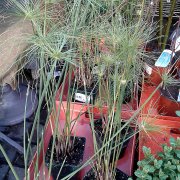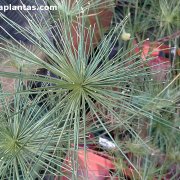Care of the aquatic plant Cyperus haspan or Dwarf papyrus sedge |
|
The genus Cyperus, family Cyperaceae, includes 700 species of annual and perennial plants distributed on all continents. Some species are: Cyperus haspan, Cyperus alternifolius, Cyperus papyrus, Cyperus gracilis, Cyperus longus, Cyperus diffusus, Cyperus esculentus. Common names: Dwarf papyrus sedge, Haspan flatsedge. This species is distributed by tropical and subtropical regions of Asia, Africa, Madagascar and America. They are perennial aquatic plants with erect triangular stems and horizontal rhizome; they reach 60 cm (1.96 feet) in height. The leaves are straight and are arranged crowning the stems in the shape of an umbrella. They do not usually bloom indoors but the flowers are of no ornamental interest. Dwarf papyrus sedge is used in pots as indoor plants; in tropical and subtropical climates it's ideal for ponds and water courses due to its easy cultivation. Cyperus haspan can grow in direct sunlight or semi-shade exposure; the climate must be warm, humid and free of frost. The soil must contain enough organic matter; It can be a commercial substrate for indoor plants with 20% compost. Watering will be frequent and abundant if it is grown in a pot so that the substrate never dries out. Haspan flatsedge perfectly tolerates waterlogging but do not resists drought. Fertilize with mineral houseplant fertilizer every 10 days in spring and summer. Cyperus haspan does not need pruning but their lateral expansion (through the rhizomes) must be monitored so that it do not become invasive plant. The biggest enemy of these plants is drought. Dwarf papyrus sedge propagates by division of rhizome or by seeds sown in spring. |
Images of the aquatic plant Cyperus haspan or Dwarf papyrus sedge |
Find plants
Cyperus haspan or Dwarf papyrus sedge | Care and Growing
© 2026 FavThemes

